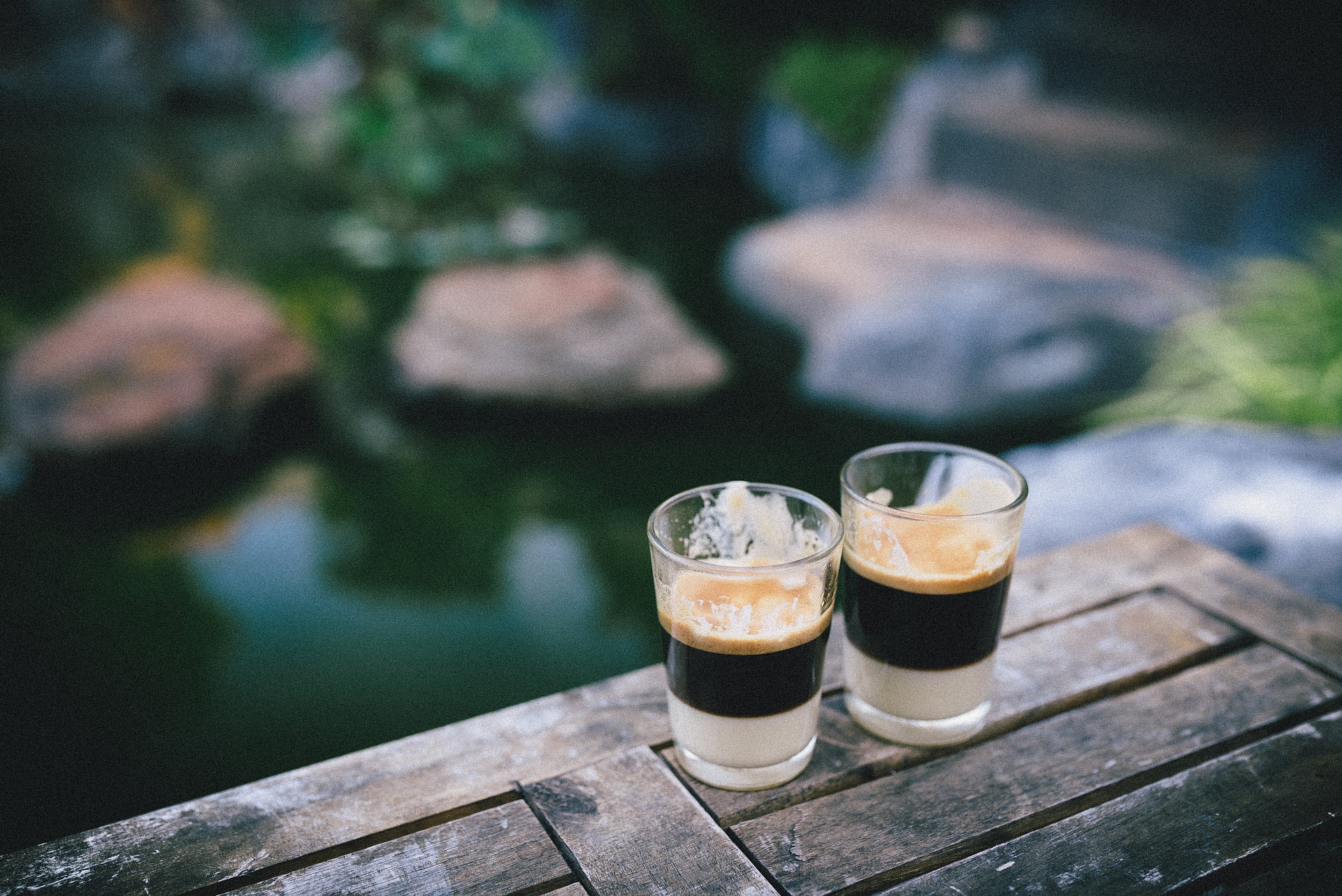Craving a rich, flavorful espresso but don’t have an espresso machine? No problem!
You can make delicious espresso at home using simple tools you probably already have.
In this guide, we’ll show you how to use an AeroPress, Moka Pot, French Press, and even a portable espresso maker.
We’ll also give you a few other bonus methods to make Espresso without needing an espresso machine.
Each method is straightforward and delivers a satisfying shot of espresso.
Ready to brew?

Understanding Espresso
What is Espresso?

Espresso is a concentrated coffee beverage.
It’s brewed by forcing hot water through finely-ground coffee beans.
This process creates a strong, full-bodied flavor that’s rich and intense.
Unlike regular coffee, espresso has a thick, syrupy consistency and a higher caffeine content.
The brewing method, not the type of coffee bean, defines espresso.
Any coffee bean can be used, but the grind must be very fine.
History of Espresso
Espresso has a fascinating history.
It was invented in the 19th century during the steam-powered industrial revolution.
The first espresso machine was created by Angelo Moriondo in 1884.
Over the years, the design and technology improved, leading to the modern espresso machines we know today.
Originally from Italy, espresso has now become a global favorite, enjoyed in various forms all around the world.
The Science Behind Espresso
Espresso is unique due to its brewing process.
High pressure, typically 9 bars, is used to push hot water through finely-ground coffee.
This pressure extracts flavors quickly, resulting in a rich and aromatic shot.
Another key feature of espresso is the crema.
Crema is the light-colored foam that forms on top of the espresso.
It consists of CO2 gas microbubbles and adds a velvety texture to the drink.
Achieving crema without an espresso machine can be challenging, but it’s a signature characteristic of true espresso.
Essential Tools and Ingredients
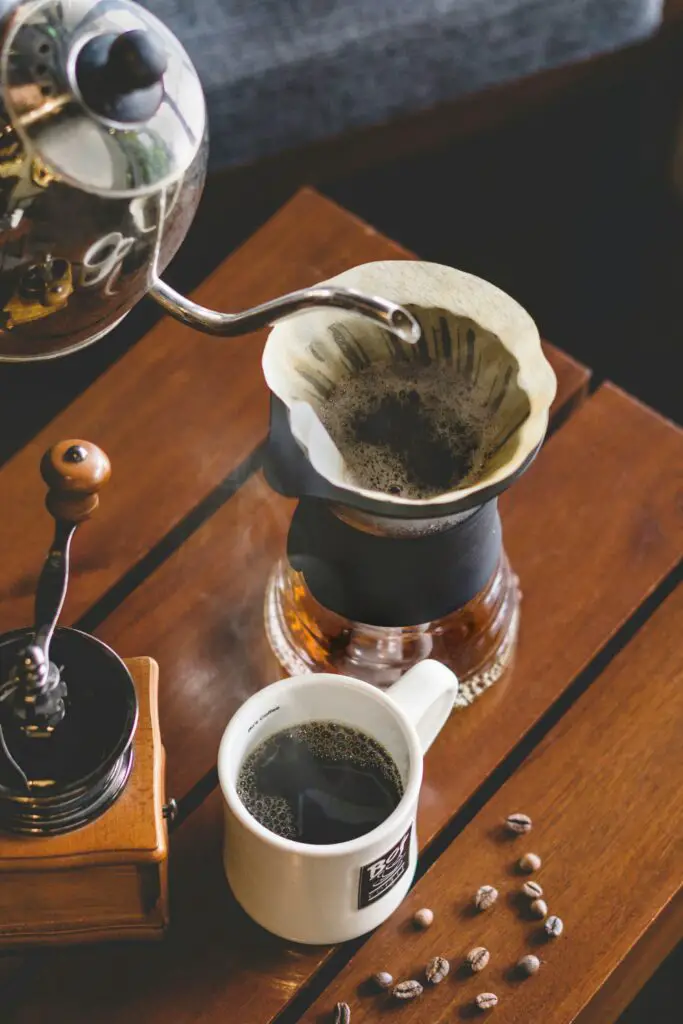
Tools You’ll Need
To make great espresso at home, you need the right tools.
First, an electric kettle with temperature control is essential.
It allows you to heat water to the precise temperature needed for espresso.
Next, a conical burr grinder is crucial.
This type of grinder ensures a consistent, fine grind, which is key for proper extraction.
A scale with a timer is also important.
It helps you measure the exact amount of coffee and water, ensuring consistency with every shot.
Finally, high-quality coffee beans are a must.
The beans you choose will greatly impact the flavor of your espresso.
Choosing the Right Coffee Beans
The quality of your coffee beans matters a lot.
High-quality beans produce a better-tasting espresso.
Look for fresh, whole beans with a strong aroma.
While you can use any type of coffee bean, certain beans are better suited for espresso.
Dark roast beans are often recommended for their rich, robust flavor.
However, medium roasts can also be used for a more balanced taste.
Ultimately, the best beans are those that suit your personal preference.
Always store your beans in an airtight container to maintain their freshness.
Method 1: AeroPress
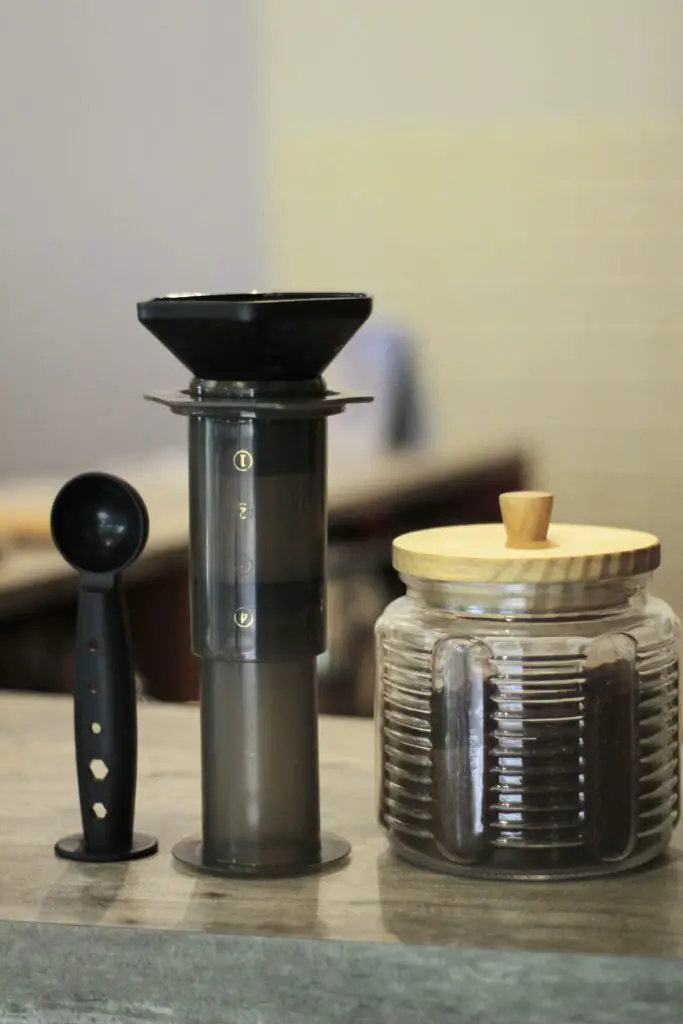
What is an AeroPress?
An AeroPress is a portable coffee maker that uses manual pressure to brew coffee.
This simple device is beloved by coffee enthusiasts for its versatility and ease of use.
One major benefit of the AeroPress is its ability to produce a rich, espresso-like coffee quickly.
It’s also compact, making it perfect for travel or small kitchens.
The AeroPress is affordable, typically costing around $30, and easy to clean.
How to Make Espresso with an AeroPress
Making espresso with an AeroPress is straightforward.
Here’s a step-by-step guide to get you started:
- Prepare the AeroPress: Start by heating water to 200-205°F. Rinse the AeroPress filter with hot water to remove any paper taste and preheat the device.
- Grind the Coffee: Use a conical burr grinder to grind 3 tablespoons of espresso beans to a fine consistency.
- Assemble the AeroPress: Place the damp filter in the filter cap and attach it to the AeroPress chamber. Set the AeroPress on a sturdy mug.
- Add Coffee Grounds: Pour the ground coffee into the AeroPress chamber and tamp lightly to level the grounds.
- Add Water: Pour 85 grams (about 3 ounces) of hot water into the chamber. Stir the mixture for about 10 seconds to ensure even extraction.
- Brew and Plunge: Insert the plunger and press down slowly and steadily until you hear a hissing sound, which indicates that the brewing is complete. This should take about 20-30 seconds.
- Serve and Enjoy: Remove the AeroPress, pour your espresso into a cup, and enjoy!
Tips for Optimal Results:
- Use fresh, high-quality beans for the best flavor.
- Experiment with water temperature and brewing time to find your preferred taste.
- Clean the AeroPress thoroughly after each use to maintain its performance.
Method 2: Moka Pot
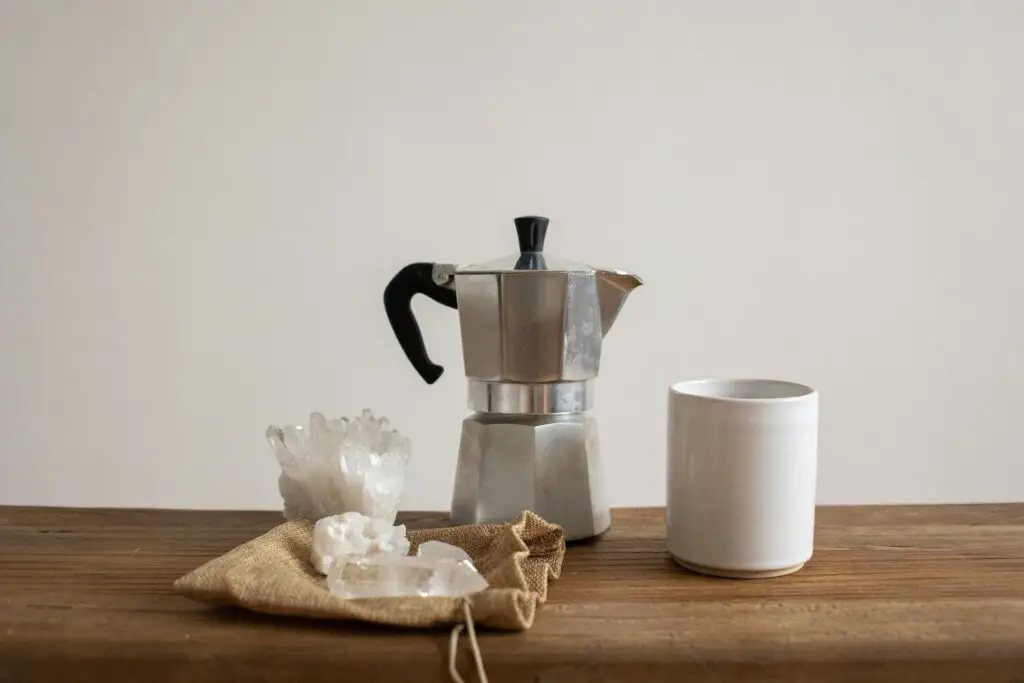
What is a Moka Pot?
A Moka Pot is a stovetop coffee maker that uses steam pressure to brew coffee, creating a rich, espresso-like drink.
Popular in many Italian homes, the Moka Pot is known for its simplicity and affordability, typically costing around $35.
It’s suitable for gas, electric, and induction stovetops.
The Moka Pot brews a strong, flavorful coffee, making it a great alternative to traditional espresso machines.
How to Make Espresso with a Moka Pot
Making espresso with a Moka Pot is easy.
Follow these steps for a perfect brew:
- Prepare the Moka Pot: Start by disassembling the Moka Pot into its three parts: the bottom chamber, the filter basket, and the top chamber.
- Add Water: Fill the bottom chamber with hot water up to the pressure valve. Using hot water helps to speed up the brewing process and prevent the coffee from tasting burnt.
- Add Coffee Grounds: Grind your coffee beans to a fine consistency. Add about 2 tablespoons of ground coffee to the filter basket, leveling it off without pressing down.
- Assemble the Moka Pot: Place the filter basket into the bottom chamber, then screw the top chamber onto the bottom chamber securely.
- Heat the Moka Pot: Place the Moka Pot on the stove over medium heat. Leave the lid open to monitor the brewing process.
- Brew the Coffee: As the water heats, steam pressure will push the hot water through the coffee grounds and up into the top chamber. You’ll hear a gurgling sound as the coffee begins to fill the top chamber.
- Finish Brewing: Once the top chamber is full and the gurgling sound stops, remove the Moka Pot from the heat. Close the lid and let it sit for a minute to settle.
- Serve and Enjoy: Pour the espresso into a cup and enjoy your rich, homemade brew.
Tips for Optimal Results:
- Use freshly ground coffee for the best flavor.
- Avoid packing the coffee grounds too tightly in the filter basket.
- Clean the Moka Pot thoroughly after each use to prevent buildup and maintain the quality of your coffee.
Method 3: French Press
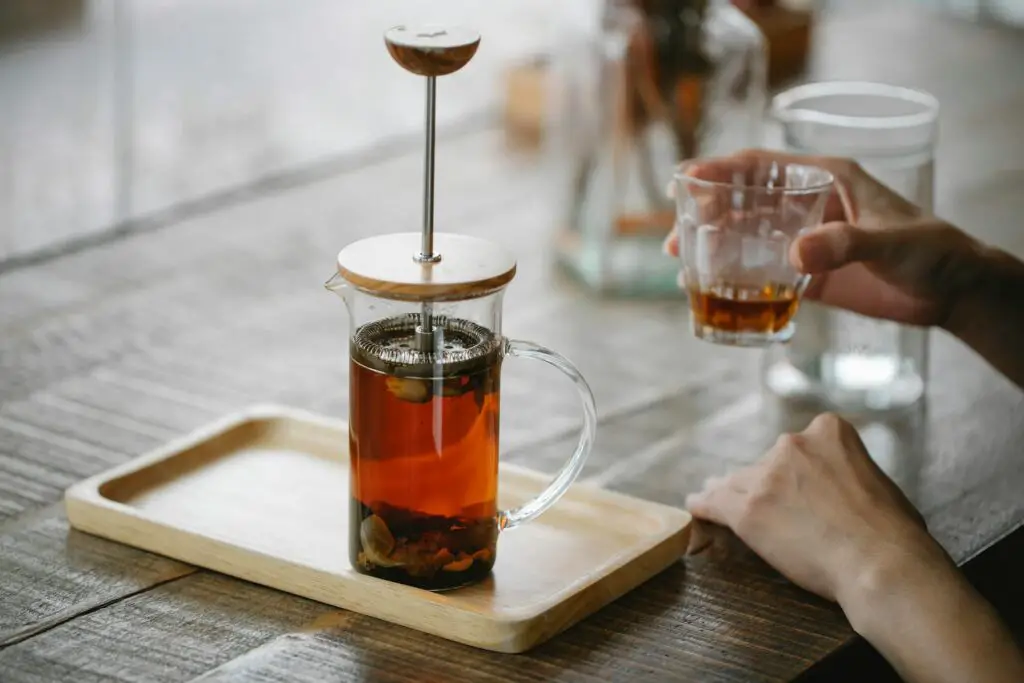
What is a French Press?
A French Press is a classic coffee brewing device.
It consists of a glass or stainless steel cylinder, a plunger, and a metal or nylon mesh filter.
Known for its simplicity and versatility, the French Press can brew various types of coffee, including a rich, espresso-like coffee.
It’s an affordable and accessible option for home brewing, typically costing between $15 and $50.
The French Press allows you to control the brewing time and temperature, ensuring a personalized coffee experience.
How to Make Espresso with a French Press
Making espresso with a French Press involves a few simple steps.
Here’s how to do it:
- Prepare the French Press: Start by preheating the French Press with hot water. This helps maintain the temperature during brewing. Discard the hot water before adding coffee.
- Grind the Coffee: Use freshly ground coffee beans. Grind them to a fine consistency, similar to table salt. You’ll need about 2 tablespoons of coffee per 6 ounces of water.
- Add Coffee Grounds: Place the coffee grounds into the bottom of the French Press.
- Heat the Water: Heat water to just below boiling, around 200°F (93°C). Using the correct temperature ensures optimal extraction.
- Pour Water Over Grounds: Pour a small amount of hot water over the coffee grounds, just enough to wet them. This is called blooming, which releases carbon dioxide and enhances flavor. Wait for 30 seconds.
- Add Remaining Water: After blooming, pour the rest of the hot water into the French Press. Give it a gentle stir to ensure all the coffee grounds are saturated.
- Brew the Coffee: Place the lid on the French Press with the plunger pulled all the way up. Let the coffee steep for 4 minutes. Steeping time is crucial for extracting the rich flavors.
- Press the Plunger: Slowly press the plunger down, applying even pressure. The mesh filter will separate the coffee grounds from the liquid.
- Serve and Enjoy: Pour the brewed espresso into your cup immediately to avoid over-extraction, which can make the coffee bitter.
Tips for Optimal Results:
- Use freshly ground coffee for the best flavor.
- Ensure the water temperature is just right, not boiling.
- Experiment with the coffee-to-water ratio to find your preferred strength.
Method 4: Portable Espresso Maker
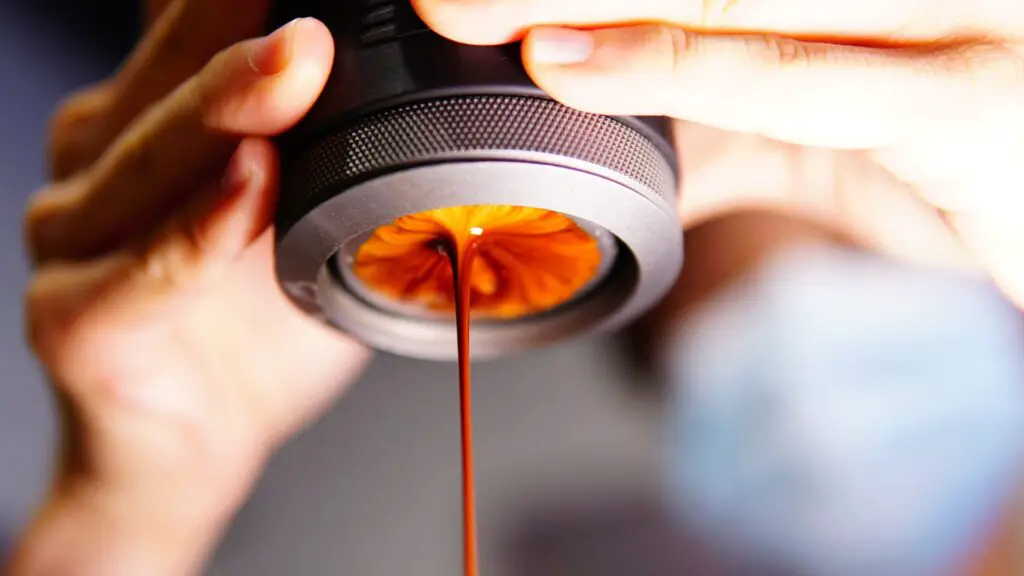
What is a Portable Espresso Maker?
A portable espresso maker is a compact, handheld device designed to brew espresso on the go.
It uses manual pressure, typically created by a pumping mechanism, to force hot water through finely-ground coffee.
These devices are lightweight and easy to carry, making them ideal for travel, camping, or small kitchens.
Portable espresso makers are affordable, with prices around $65.
They offer the convenience of enjoying espresso anywhere without the need for electricity.
How to Make Espresso with a Portable Espresso Maker
Making espresso with a portable espresso maker is simple and convenient.
Follow these steps for a perfect brew:
- Prepare the Portable Espresso Maker: Disassemble the device according to the manufacturer’s instructions. Preheat the components by rinsing them with hot water to maintain the temperature during brewing.
- Grind the Coffee: Use a conical burr grinder to grind your coffee beans to a fine consistency. You’ll need about 2 tablespoons of coffee.
- Add Coffee Grounds: Fill the coffee basket with the finely-ground coffee. Tamp the grounds lightly to ensure even extraction.
- Heat the Water: Boil water and let it cool slightly, aiming for a temperature around 200°F (93°C).
- Assemble the Device: Put the coffee basket into the device and securely attach all parts according to the manufacturer’s guidelines.
- Add Water: Pour the hot water into the water reservoir of the portable espresso maker.
- Create Pressure: Use the manual pumping mechanism to generate pressure. This forces the hot water through the coffee grounds, extracting the espresso.
- Brew and Serve: Continue pumping until the espresso is fully extracted and fills the cup. This usually takes about 30 seconds to a minute.
- Enjoy Your Espresso: Pour the freshly brewed espresso into a cup and enjoy.
Tips for Optimal Results:
- Use freshly ground coffee for the best flavor.
- Preheat all components to maintain the correct brewing temperature.
- Follow the manufacturer’s instructions carefully for the best results.
Other Methods to Make Espresso Without a Machine
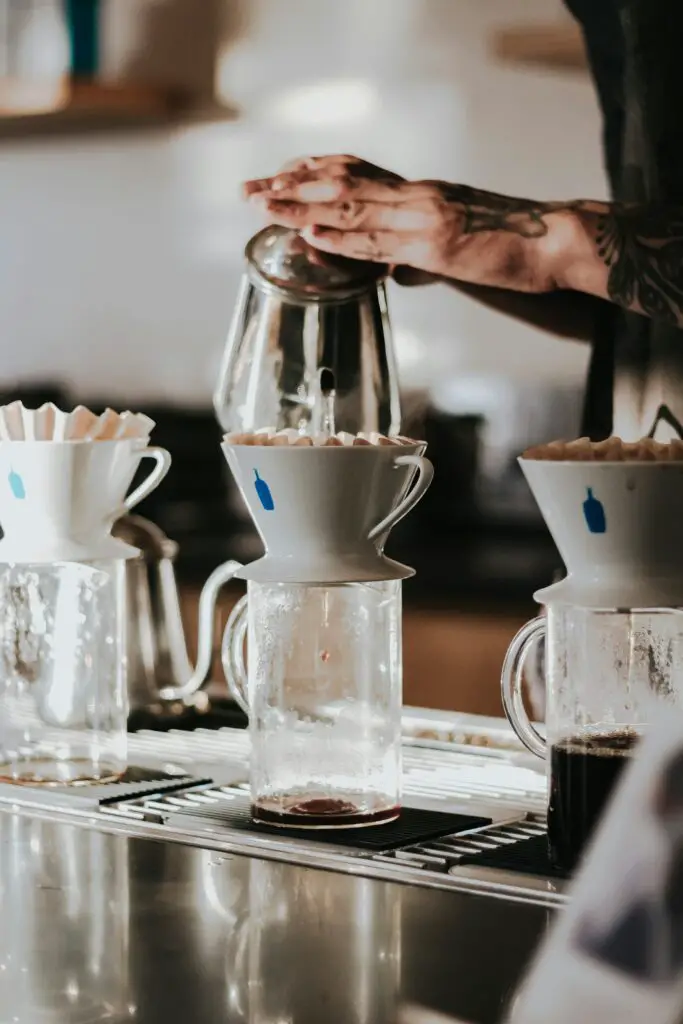
The Immersion Process
The immersion process is a simple way to make espresso without any fancy equipment.
Here’s how you can do it:
- Grind the Coffee: Use a conical burr grinder to grind your coffee beans to a fine consistency. You’ll need about 2 tablespoons of coffee.
- Heat the Water: Boil water and let it cool slightly, aiming for a temperature around 200°F (93°C).
- Combine Coffee and Water: Place the coffee grounds in a heatproof container. Pour 3 ½ ounces of hot water over the grounds.
- Steep the Coffee: Let the coffee steep for about 4 minutes. This allows the water to extract the flavors from the coffee.
- Strain the Coffee: Use a fine mesh strainer or a paper filter to separate the coffee grounds from the liquid. Pour the strained coffee into a cup and enjoy your homemade espresso.
Tips for Optimal Results:
- Ensure the coffee grounds are evenly saturated.
- Adjust steeping time to suit your taste preference.
Mason Jar Espresso
Making espresso with a mason jar is a creative and budget-friendly method.
Here’s how to do it:
- Grind the Coffee: Use a conical burr grinder to grind your coffee beans to a fine consistency. You’ll need about 2 tablespoons of coffee.
- Heat the Water: Boil water and let it cool slightly, aiming for a temperature around 200°F (93°C).
- Combine Coffee and Water: Place the coffee grounds in a mason jar. Add 3 ½ ounces of hot water.
- Shake the Jar: Secure the lid tightly and shake the jar vigorously for about 30 seconds. This mimics the pressure used in traditional espresso making.
- Steep the Coffee: Let the coffee steep for an additional 3-4 minutes.
- Strain the Coffee: Use a fine mesh strainer or a paper filter to separate the coffee grounds from the liquid. Pour the strained coffee into a cup and enjoy.
Tips for Optimal Results:
- Shake the jar thoroughly to ensure even extraction.
- Adjust the steeping time to modify the strength of your espresso.
Instant Coffee Espresso
Making an espresso-like drink with instant coffee is quick and easy.
Here’s how to do it:
- Choose Quality Instant Coffee: Select a high-quality instant coffee for the best results. Look for one labeled as espresso or dark roast.
- Boil Water: Boil water and let it cool slightly, aiming for a temperature around 200°F (93°C).
- Combine Coffee and Water: Add 1-2 teaspoons of instant coffee to a cup. Pour 3 ½ ounces of hot water over the coffee.
- Stir and Serve: Stir the coffee until the instant coffee granules are fully dissolved. Adjust the amount of instant coffee to suit your taste.
Tips for Optimal Results:
- Use less water for a stronger flavor.
- Add a small amount of sugar or milk if desired.
Additional Tips and Tricks

Choosing the Right Grind Size and Roast
The grind size and roast level are crucial for making great espresso.
For each method, the grind size should be fine, similar to table salt.
A fine grind ensures proper extraction, giving your espresso its rich flavor and crema.
If the grind is too coarse, the coffee will be weak and watery.
When it comes to roast levels, dark roasts are often preferred for espresso due to their robust flavor.
However, medium roasts can also work well, offering a balanced taste with less bitterness.
Experiment with different roasts to find what suits your palate best.
Water Temperature
Water temperature plays a vital role in brewing espresso.
The ideal temperature for brewing espresso is between 195°F and 205°F (90°C to 96°C).
Water that is too hot can burn the coffee, resulting in a bitter taste.
Conversely, water that is too cool will under-extract the coffee, making it taste sour and weak.
Use an electric kettle with temperature control to ensure your water is at the right temperature.
If you don’t have one, let boiling water sit for about 30 seconds before using it to brew your coffee.
How Long to Steep Coffee Grounds
Steeping time affects the flavor and strength of your espresso.
Here are the recommended steeping times for each method:
- AeroPress: Steep for about 30 seconds after blooming.
- Moka Pot: No steeping is required, but the brewing process takes about 5 minutes.
- French Press: Steep for 4 minutes.
- Immersion Process: Steep for 4 minutes.
- Mason Jar: Steep for 4 minutes.
Adjust the steeping time to suit your taste.
Longer steeping results in a stronger, more intense flavor, while shorter steeping produces a milder coffee.
Tips for Perfecting Your Espresso
Making espresso at home can be a bit tricky.
Here are some common mistakes and how to avoid them:
- Using the Wrong Grind Size: Ensure your coffee is ground to a fine consistency. Too coarse, and the coffee will be weak; too fine, and it will be over-extracted and bitter.
- Incorrect Water Temperature: Use water at the right temperature, between 195°F and 205°F. Too hot or too cold water will affect the taste.
- Not Measuring Properly: Use a scale to measure your coffee and water accurately. Consistency is key to making great espresso.
- Not Preheating Equipment: Preheat your brewing equipment with hot water to maintain the right brewing temperature.
Espresso Drinks You Can Make at Home
With your homemade espresso, you can create a variety of delicious drinks.
Here are some popular espresso-based recipes:
Latte
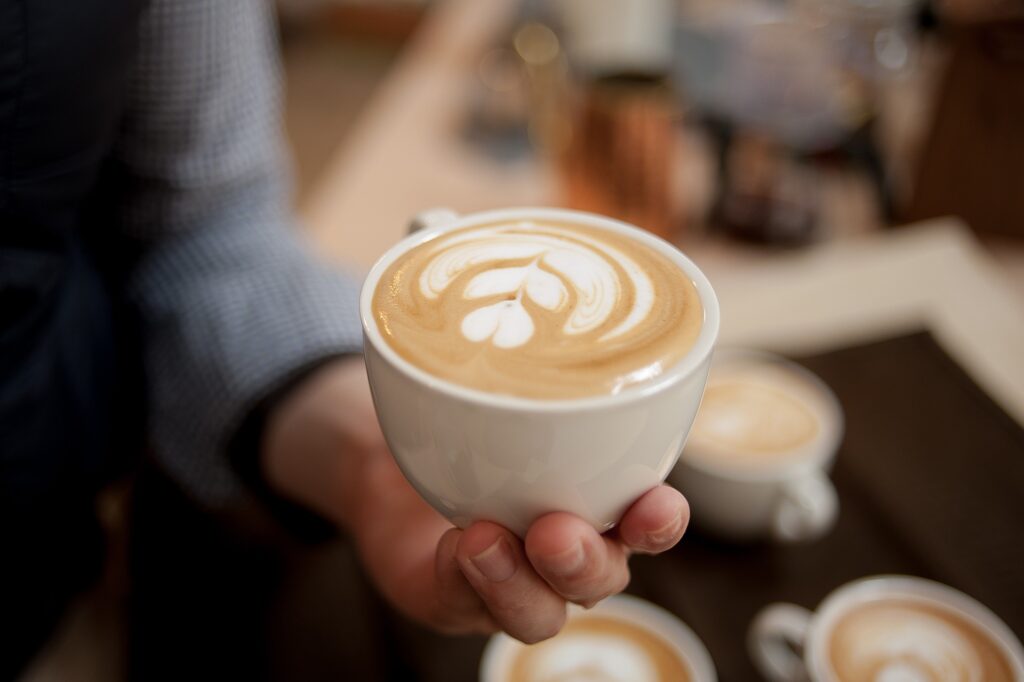
A latte is a creamy coffee drink made with espresso and steamed milk.
- Ingredients: 1 shot of espresso, 8 ounces of steamed milk, and a small amount of milk foam.
- Instructions: Brew the espresso and pour it into a cup. Steam the milk and pour it over the espresso. Top with a small layer of milk foam.
Cappuccino
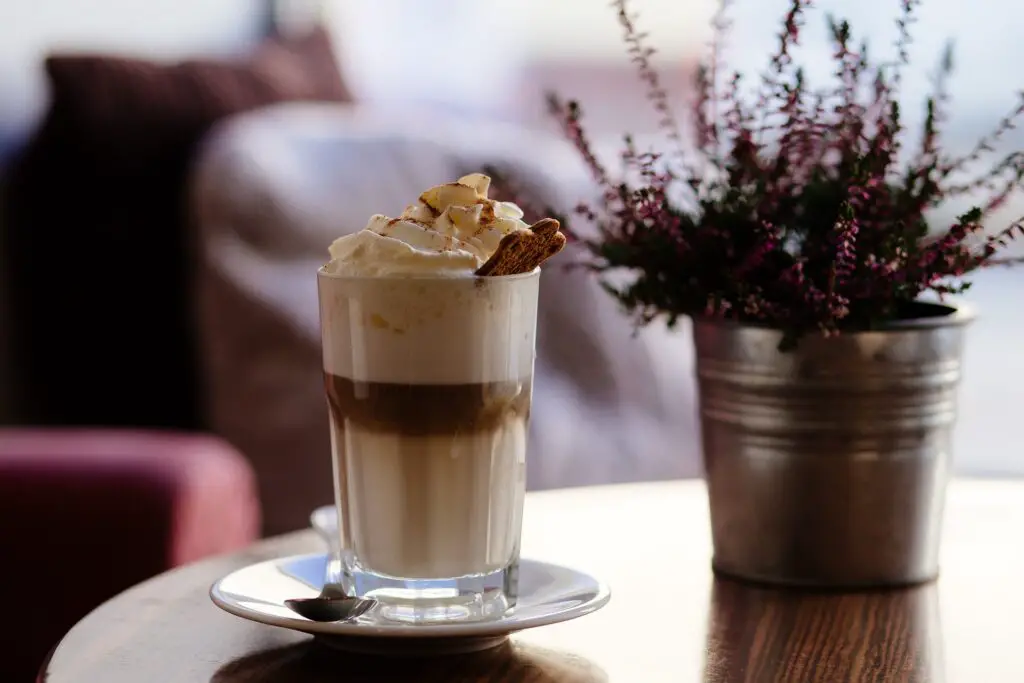
A cappuccino is similar to a latte but has more foam and less milk.
- Ingredients: 1 shot of espresso, 4 ounces of steamed milk, and 4 ounces of milk foam.
- Instructions: Brew the espresso and pour it into a cup. Steam the milk and pour it over the espresso, holding back the foam with a spoon. Spoon the foam on top.
Flat White
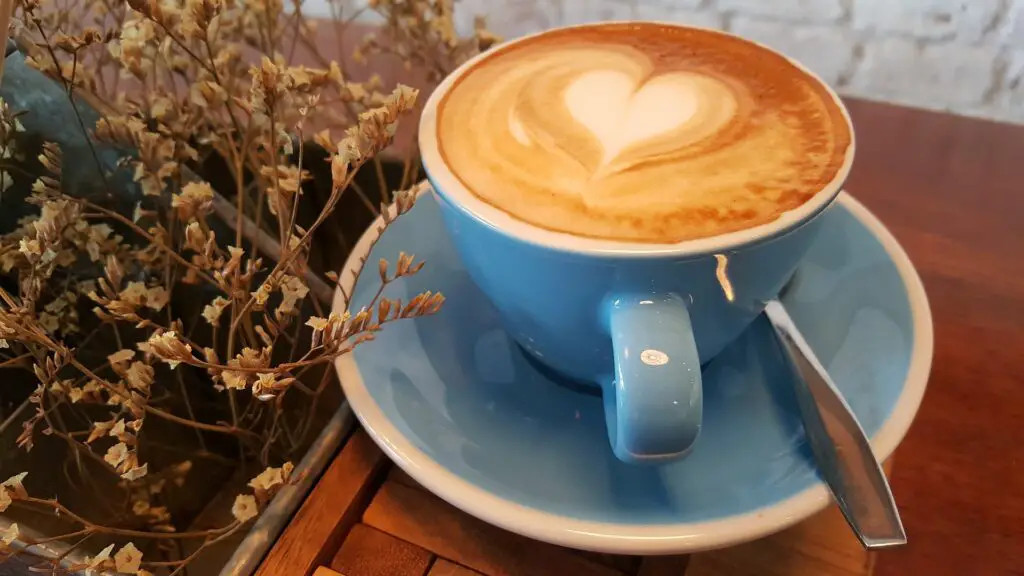
A flat white is a smoother and creamier version of a latte with a higher coffee-to-milk ratio.
- Ingredients: 1 shot of espresso, 6 ounces of steamed milk.
- Instructions: Brew the espresso and pour it into a cup. Steam the milk and pour it over the espresso, creating a smooth blend.
Americano
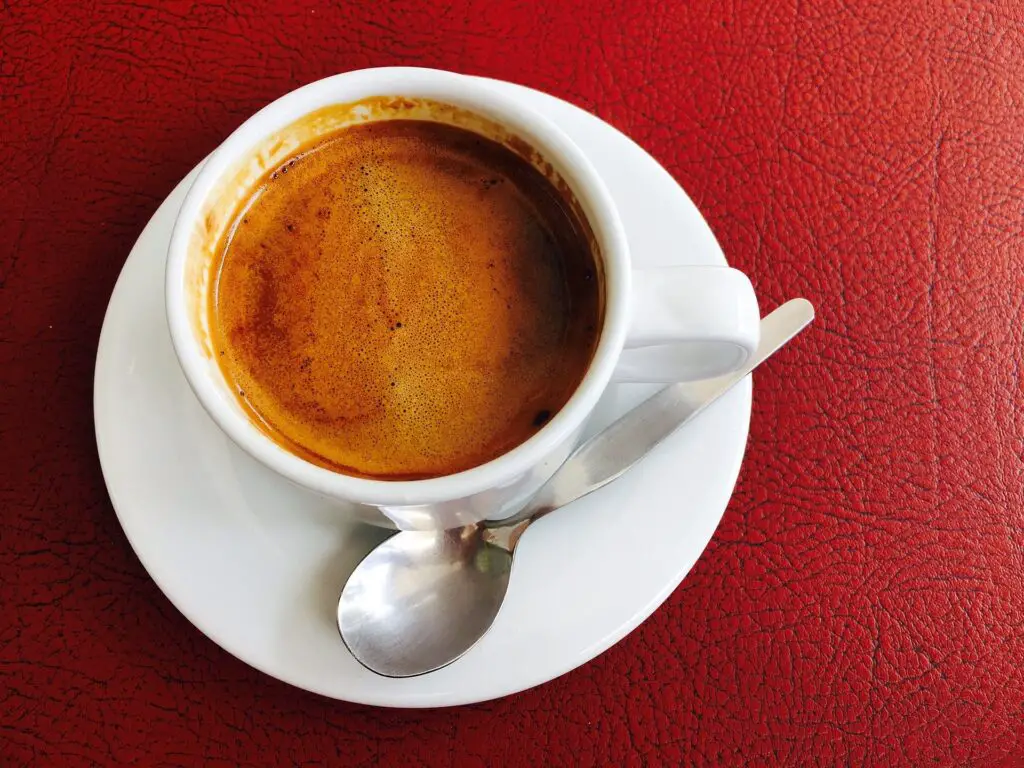
An Americano is a simple and strong coffee drink made by diluting espresso with hot water.
- Ingredients: 1 shot of espresso, 6-8 ounces of hot water.
- Instructions: Brew the espresso and pour it into a cup. Add hot water to the espresso to dilute it to your preferred strength.
Macchiato
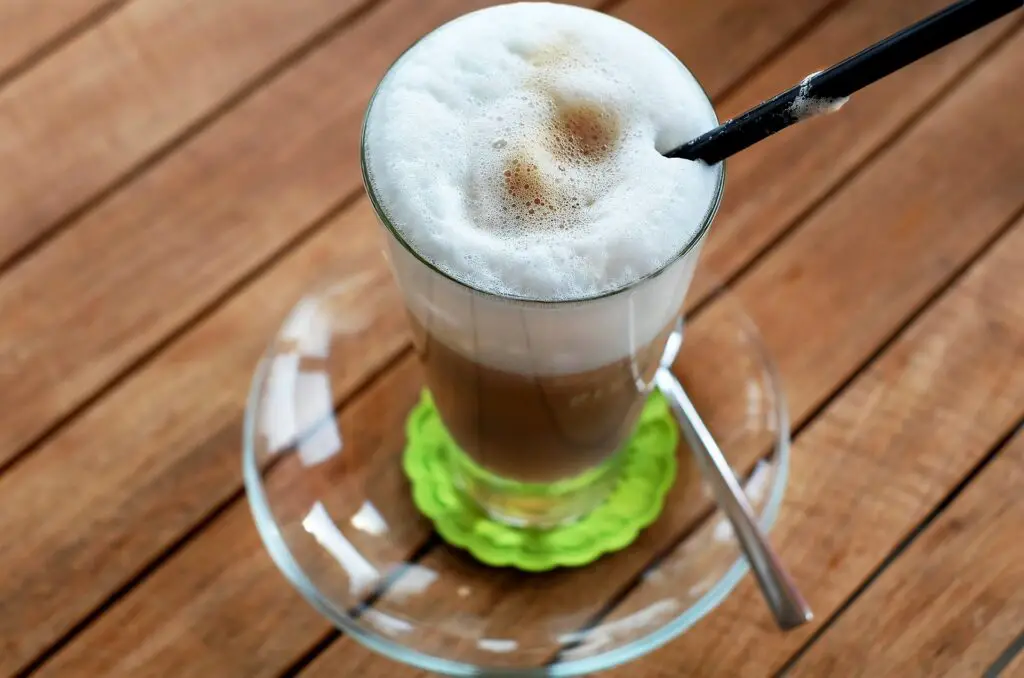
A macchiato is an espresso with a small amount of milk foam.
- Ingredients: 1 shot of espresso, a dollop of milk foam.
- Instructions: Brew the espresso and pour it into a small cup. Spoon a dollop of milk foam on top.
Cortado
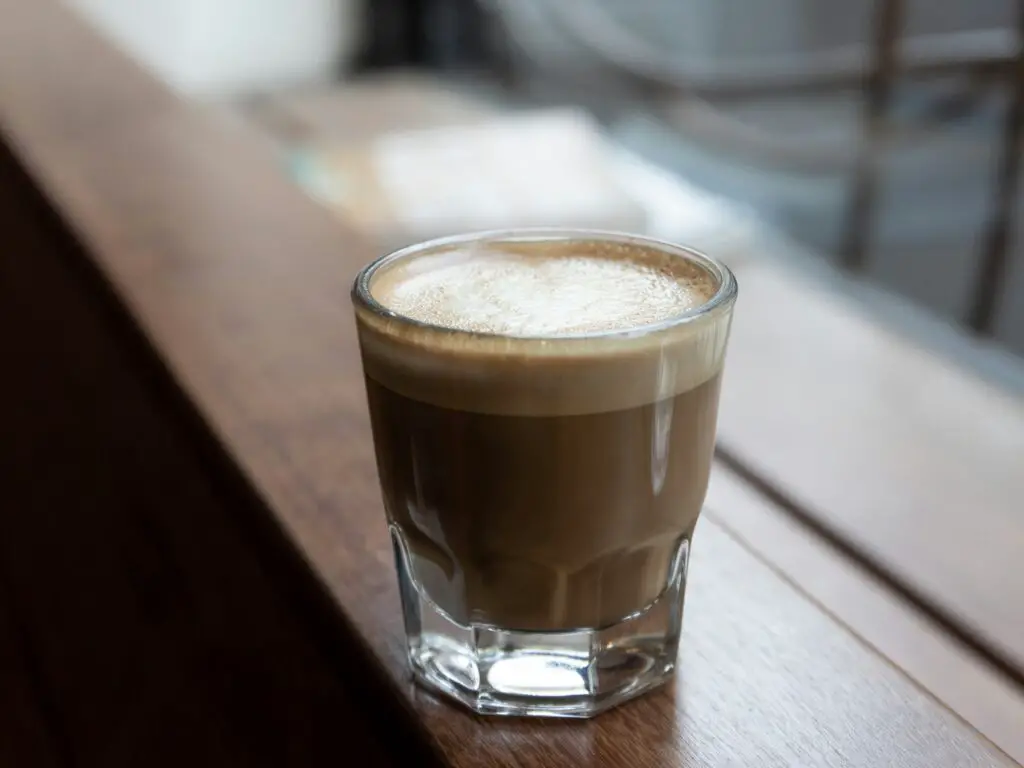
A cortado is a balanced drink with equal parts espresso and steamed milk.
- Ingredients: 1 shot of espresso, 1 shot of steamed milk.
- Instructions: Brew the espresso and pour it into a cup. Steam the milk and pour it over the espresso in equal parts.
Mocha

A mocha is a chocolate-flavored coffee drink made with espresso, steamed milk, and chocolate syrup.
- Ingredients: 1 shot of espresso, 1 tablespoon of chocolate syrup, 8 ounces of steamed milk, whipped cream (optional).
- Instructions: Brew the espresso and pour it into a cup. Add the chocolate syrup and stir well. Steam the milk and pour it over the espresso. Top with whipped cream if desired.
Iced Latte
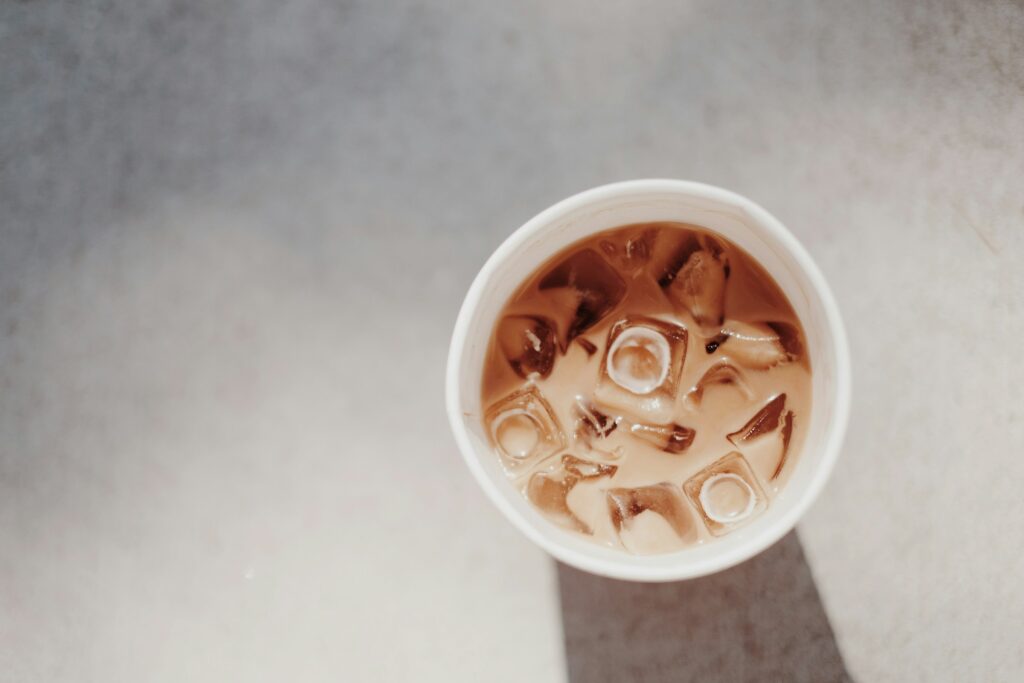
An iced latte is a refreshing cold coffee drink made with espresso, milk, and ice.
- Ingredients: 1 shot of espresso, 8 ounces of cold milk, ice cubes.
- Instructions: Brew the espresso and let it cool slightly. Fill a glass with ice cubes. Pour the espresso over the ice, then add the cold milk.
Espresso Martini

An espresso martini is a sophisticated cocktail made with espresso, vodka, and coffee liqueur.
- Ingredients: 1 shot of espresso, 1 ½ ounces of vodka, 1 ½ ounces of coffee liqueur, ice.
- Instructions: Brew the espresso and let it cool. Fill a shaker with ice. Add the cooled espresso, vodka, and coffee liqueur. Shake well and strain into a martini glass.
Conclusion
Making espresso at home without a machine is easier than you might think.
With methods like the AeroPress, Moka Pot, French Press, and portable espresso makers, you can enjoy rich, flavorful espresso anytime.
Each method has its own unique benefits and steps, so feel free to experiment.
Remember, the right tools and high-quality beans make a big difference.
Don’t be afraid to adjust grind size, water temperature, and brewing time to suit your taste.
Enjoy the process and find your favorite way to brew espresso at home.
Happy brewing!


